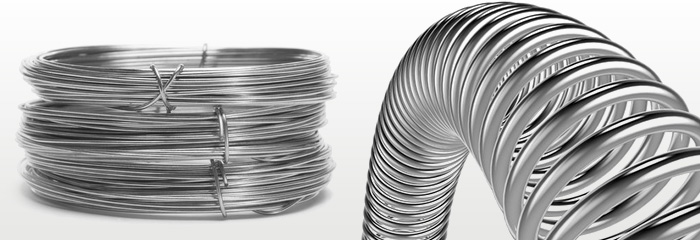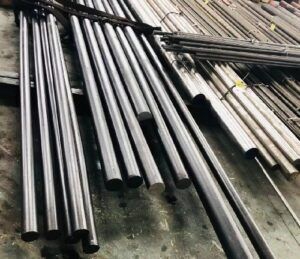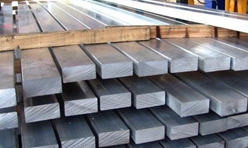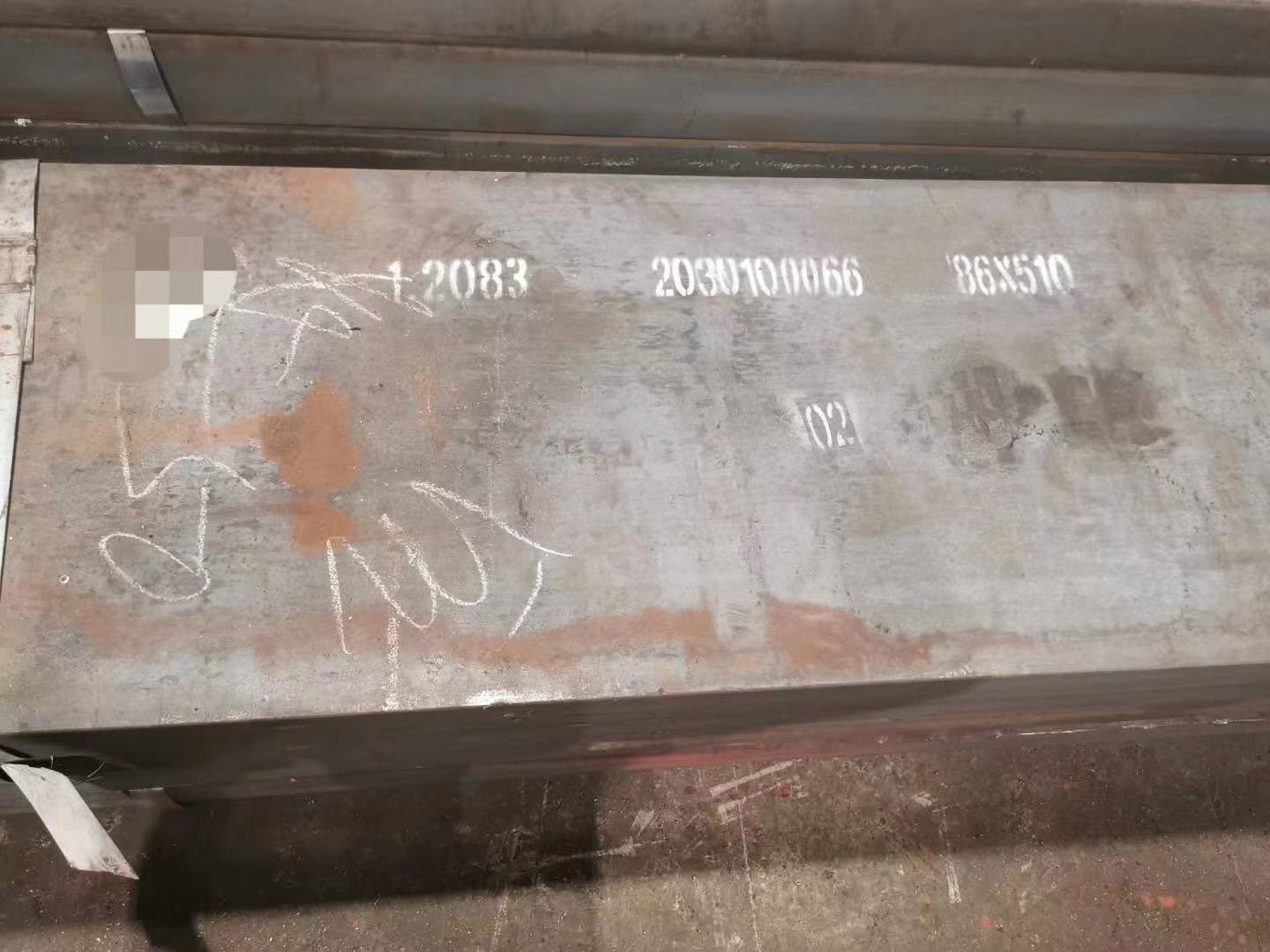
stainless steel spring steel wire
1. Stainless Steel Wire For Spring
The corrosion resistance of stainless steels removes the requirement for any additional protective coatings making them the ideal material for springs operating in a range of corrosive conditions, high temperatures and in locations where maintenance and replacement are difficult.
2. Why choose our stainless steel spring wire?
All Stainless spring wires are manufactured to a high and consistent quality including;
Tensile strength – offering consistent spring forming capabilities.
Surface finish and soap coating – to lubricate and aid the forming of the springs when running at high speeds through spring forming machines providing good spring coiling characteristics.
Cast & helix – offering maximum product performance.
The spring properties of stainless spring wires are obtained by precision cold drawing meaning the tensile strength of the spring wires are maintained at operating temperatures up to 250°C with stainless steel springs able to be used in reduced stress levels up to 450°C.
3. What kind of stainless steel spring wire?
Currently there are about 10 international common stainless spring steel wire grades, according to the microstructure can be divided into martensitic, ferritic, austenitic three types; according to processing and use can be divided into phase change reinforced, deformation-reinforced and precipitation-hardened three types.
3.1 Martensitic stainless steel wire
Martensitic steel wire is a phase change reinforced spring steel wire, more lightly drawn or annealed state of supply, the wire into a spring after winding and then quenched – tempered, tempered martensitic or sartensitic organization. Annealed or lightly drawn martensitic steel wire, moderate strength, good flexibility, can be processed into a variety of complex shapes of the spring element, after quenching and tempering of the spring element performance uniform, isotropic, with good corrosion resistance, in the air, water, water vapor and some weak acidic media have a more stable fatigue limit. Commonly used grades are 414, 420, 420J2, 431, 15Х12Н2МФ, 420S45, 431S29 and 441S49, and so on. Spring martensitic wire finished product tensile strength generally does not exceed 950MPa
3.2 Ferritic stainless steel wire
Ferritic stainless steel wire can not be strengthened by quenching – tempering, a deformation-reinforced spring steel wire. Generally speaking, the corrosion resistance of ferritic stainless steel is slightly better than martensitic stainless steel, ferritic steel wire cold working performance is good, can withstand more than 90% reduction in face rate of drawing, but its cold working strengthened coefficient is low, the finished wire tensile strength is generally not more than 1100N / mm2, more for the production of low-stress spring, or further processed into a complex shape of the shaped spring. Common grades 409, 409Nb, 430, 434, SUS430 and GARBA17C1, etc..
3.3 Austenitic stainless steel wire
Austenitic stainless steel has excellent corrosion resistance, excellent cold working plasticity, and a high cold working strengthening factor, can be drawn by a large reduction in face rate to achieve a high strength. It is used to make elastic elements for use in corrosive environments and various corrosive media. From the petroleum, chemical, textile and other traditional industrial sectors, to food processing, home appliances, household cosmetics, austenitic stainless spring steel wire has a role in weight. Austenitic stainless steel is divided into 200 series, 300 series and precipitation hardening type three categories. Commonly used grades are 302, 304H, 316H, SUS302, SUS304, SUS304N1, SUS316, 302S26, 301S81, X12CrNi17.7, XM-28, 201 and S20430 (204Cu).
4. Specification of stainless steel wire
ASTM A313M-2003 Stainless Spring Steel Wires
JIS G4314-1994 Stainless steel wire for springs
DIN17224-1982 stainless spring steel wire and spring steel strip
BS2056-1991 Stainless steel wire for mechanical springs
EN10270-3:2001 Stainless spring steel wires
ISO6931-1-1994(E) Stainless steel for springs Part 1: Steel wire
5.Stainless steel spring wire grade
| European standards | Designation USA | Japan | Former French standards | ||
| EN 10088-3 | |||||
| Grades | Designation | AISI- ASTM- SAE | UNS | SUS | NF |
| AUSTENITIC GRADES | |||||
| 1.4301 | X5CrNi18-10 | 304 | S30400 | 304 | Z7CN1809 |
| 1.431 | X10CrNi18-8 | 302 | S30200 | 302 | Z12CN18-09 |
| 1.4305 | X8CrNiS18-9 | 303 | S30300 | 303 | Z8CNF18-09 |
| 1.4306 | X2CrNi19-11 | 304L | – | – | Z3CN19-11 |
| 1.4303 | X4CrNi18-9 | 305 | S30500 | 305 | Z5CN18-11 FF |
| 1.4307 | X2CrNi18-9 | 304L | S30403 | 304L | Z3CN19-09 |
| 1.4401 | X5CrNiMo17-12-2 | 316 | S31600 | 316 | Z7CND17-11-02 |
| 1.4404 | X2CrNiMo17-12-2 | 316L | S31603 | 316L | Z3CND17-11-02 |
| 1.4541 | X5CrNiTi18-10 | 321 | S32100 | 321 | Z6CNT18-10 |
| 1.4567 | X3CrNiCu18-9-4 | 302HQ-304Cu | S30430 | XM7 | Z3CNU18-10 |
| 1.457 | X6CrNiCuS18-9-2 | – | – | – | Z8CNUF18.09 |
| 1.4571 | X6CrNiMoTi17-12-2 | 316Ti | S31635 | 316Ti | Z6CNDT17-12 |
| 14,597 | X8CrMnCuNB17-8-3 | 204Cu | – | – | – |
| 1.4539 | X1NiCrMoCu25-20-5 | 904L | NO8904 | – | Z2NCDU25-20 |
| REFRACTORY GRADES | |||||
| 1.4841 | X15CrNiSi25-21 | 314 | S31400 | – | Z15CNS25-20 |
| 1.4845 | X8CrNi25-21 | 310-310S | S31000 | SUH310 | Z8CN25-20 |
| FERRITIC GRADES | |||||
| 1.4016 | X6Cr 17 | 430 | S43000 | 430 | Z8C17 |
| 1.4104 | X14CrMoS17 | 430F | S43020 | 430F | Z10CF17 |
| 1.4509 | X2CrTiNb18 | 441 | S44100 | 441 | – |
| 1.451 | X3CrTi17 | 439/XM8 | S43035 | – | Z4CT17 |
| 1.4511 | X3CrNb17 | 430Cb | – | – | Z4CNb17 |
| 14,512 | X2CrTi12 | 409 | S40920 | – | Z3CT12 |
| MARTENSITIC GRADES | |||||
| 1.4005 | X12CrS13 | 416 | S41600 | 416 | Z12CF13 |
| 14,034 | X46Cr13 | 420C | – | – | Z20C14 |
| 1.4021 | X20Cr13 | 420A | S4200 | – | Z40C13 |
| 14,035 | X46CrS13 | – | – | – | – |
6. Mechanical Property
| JIS G4314 Tensile Strength | ||||
| A | B | C | D | |
| SUS302-WPA SUS304-WPA SUS304N1-WPA SUS316-WPA | SUS302-WPB SUS304-WPB SUS304-WPBS SUS304N1-WPB | SUS631J1-WPC | SUS304-WPDS | |
| 0.080 | 1650-1900 | 2150-2400 | – | – |
| 0.090 | – | – | ||
| 0.10 | 1950-2200 | – | ||
| 0.12 | – | |||
| 0.14 | – | |||
| 0.16 | – | |||
| 0.18 | – | |||
| 0.20 | – | |||
| 0.23 | 1600-1850 | 2050-2300 | 1930-2180 | – |
| 0.26 | – | |||
| 0.29 | 1700-2000 | |||
| 0.32 | ||||
| 0.35 | ||||
| 0.40 | ||||
| 0.45 | 1950-2200 | 1850-2100 | 1650-1950 | |
| 0.50 | ||||
| 0.55 | ||||
| 0.60 | ||||
| 0.65 | 1530-1780 | 1850-2100 | 1800-2050 | 1550-1850 |
| 0.70 | ||||
| 0.80 | 1550-1800 | |||
| 0.90 | ||||
| 1.00 | 1500-1750 | |||
| 1.20 | 1450-1700 | 1750-200 | 1700-1950 | 1470-1720 |
| 1.40 | 1420-1670 | |||
| 1.60 | 1400-1650 | 1650-1900 | 1600-1850 | 1370-1620 |
| 1.80 | – | |||
| 2.00 | – | |||
| 2.30 | 1320-1570 | 1550-1800 | 1500-1750 | – |
| 2.60 | – | |||
| 2.90 | 1230-1480 | 1450-1700 | 1400-1650 | – |
| 3.20 | – | |||
| 3.50 | – | |||
| 4.00 | – | |||
| 4.50 | 1100-1350 | 1350-1600 | 1300-1550 | – |
| 5.00 | – | |||
| 5.50 | – | |||
| 6.00 | – | |||
| 6.50 | 1000-1250 | 1270-1520 | – | – |
| 7.00 | – | – | ||
| 8.00 | – | – | ||
| 9.00 | – | 1130-1380 | – | – |
| 10.0 | 980-1230 | – | – | |
| 12.0 | 880-1130 | – | – | |
7. Surface condition of spring steel spring wire
Standard provisions of the wire surface bright or clean, can be divided into matte, bright, clean and coated (plated) surface of the four surface states, the demand side does not indicate when the supplier to determine the surface state.
7.1 Matte wire surface silver-white, non-reflective. The surface is lusterless, foggy. The vast majority of spring steel wire are supplied in the matte state.
7.2 Glossy wire surface shiny, like a mirror-like reflective. Glossy wire is mainly used to produce springs for use in decorative applications, generally for wire diameters up to 3.0 mm.
7.3 Clean surface refers to the surface of the wire after cleaning to remove residual lubricating film, the surface is clean, smooth, oil-free.
8. Property test of spring steel spring wire
8.1 Spring steel wire is ultimately wrapped into various shapes of the spring used, the wire must have good cold forming performance, often referred to as process performance. Assessment of the technological performance of the wire test methods are bending test, twisting test and winding test.
8.2 Reference to JIS G4314 standard, Φ0.5 ~ 4.0mm wire twisting test, the provisions of the twisting surface of the wire shall not have cracks, folds and spines, twisting fracture should be perpendicular or nearly perpendicular to the axis, there shall be no cracking or layering.
8.3 Refer to ASTM A313 and ISO6931 standards, Φ ≤ 6.0mm wire winding test, the provisions of the wire diameter less than or equal to 4.00mm wire should be winding test, the wire along the wire diameter equal to the size of the mandrel winding 8 times, there should be no fracture. Wire diameter greater than 4.00 ~ 6.00mm, winding along the diameter equal to two times the size of the wire mandrel five times, should not break.
8.4 Refer to BS2056 and ISO6931 standards, bending test of Φ>6.0mm wire, which states that “wire diameter greater than 6.00mm, along the r = 10mm arc in different directions, bending 90 °, the surface shall not have cracks or cracks.




